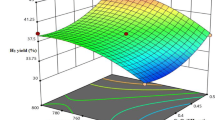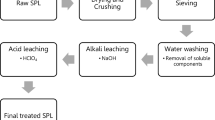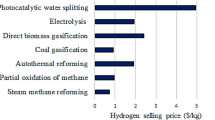Abstract
The reforming of methane by carbon dioxide for the production of syngas is a potential technological route for the mitigation of greenhouse gases. However, the process is highly endothermic and often accompanied by catalyst deactivation from sintering and carbon deposition. Besides, the applications of dissimilar catalytic systems in methane dry reforming have made it difficult to obtain generalized optimum conditions for the desired products. Hence, optimization studies of any catalytic system often resulted in a unique optimum condition. The present study aimed to investigate optimum conditions of variables such as methane (CH4) partial pressure, carbon dioxide (CO2) partial pressure and reaction temperature that will maximize syngas yields from methane dry reforming over samarium oxide supported cobalt (Co/Sm2O3) catalyst. The Co/Sm2O3 catalyst was synthesized using wet-impregnation method and characterized by thermogravimetric analysis), field emission scanning electron microscopy, energy-dispersive X-ray spectroscopy, X-ray powder diffraction and nitrogen (N2) physisorption. Syngas production by methane dry reforming over the synthesized Co/Sm2O3 catalyst was investigated in a stainless steel fixed-bed reactor. The process variables (CH4 partial pressure, CO2 partial pressure and reaction temperature) for the syngas production were optimized using response surface methodology (RSM). The RSM and artificial neural networks (ANNs) were used to predict the syngas production from the experimental data. The comparative analysis between the two models showed that the ANN model has better prediction of the syngas yields compared to the RSM model as evident from the good agreement between the observed and the predicted values. At maximum desirability value of 0.97, optimum CH4 and CO2 partial pressures of 47.9 and 48.9 kPa were obtained at reaction temperature of 735 °C resulting in syngas yield of ~79.4 and 79.0% for hydrogen (H2) and carbon monoxide (CO), respectively.





Similar content being viewed by others
References
Agatonovic-Kustrin S, Beresford R (2000) Basic concepts of artificial neural network (ANN) modeling and its application in pharmaceutical research. J Pharm Biomed Anal 22(5):717–727
Amini Y, Fattahi M, Khorasheh F, Sahebdelfar S (2013) Neural network modeling the effect of oxygenate additives on the performance of Pt–Sn/γ-Al2O3 catalyst in propane dehydrogenation. Appl Petrochemical Res. 3(1–2):47–54
Ayodele BV, Cheng CK (2015) Modelling and optimization of syngas production from methane dry reforming over ceria-supported cobalt catalyst using artificial neural networks and Box-Behnken design. J Ind Eng Chem 32:246–258
Ayodele BV, Hossain MA, Chong SL, Soh JC, Abdullah S, Khan MR, Cheng CK (2016a) Non-isothermal kinetics and mechanistic study of thermal decomposition of light rare earth metal nitrate hydrates using thermogravimetric analysis. J Therm Anal Calorim 125(1):423–435
Ayodele BV, Hossain SS, Lam SS, Osazuwa OU, Khan MR, Cheng CK (2016b) Syngas production from CO2 reforming of methane over neodymium sesquioxide supported cobalt catalyst. J Nat Gas Sci Eng. 34:873–885
Ayodele BV., Khan MR, Cheng CK. Syngas production from CO2 reforming of methane over ceria supported cobalt catalyst: Effects of reactants partial pressure. J Nat Gas Sci Eng. 34:873-885
Ayodele BV, Khan MR, Cheng CK (2016c) Greenhouse gases mitigation by CO2 reforming of methane to hydrogen-rich syngas using praseodymium oxide supported cobalt catalyst. Clean Technol Environ Policy. Springer, Berlin Heidelberg, pp 1–13
Ayodele BV, Khan MR, Lam SS, Cheng CK (2016d) Production of CO-rich hydrogen from methane dry reforming over lanthania-supported cobalt catalyst: kinetic and mechanistic studies. Int J Hydrogen Energy 41(8):4603–4615
Bouarab R, Akdim O, Auroux A, Cherifi O, Mirodatos C (2004) Effect of MgO additive on catalytic properties of Co/SiO2 in the dry reforming of methane. Appl Catal A Gen. 264(2):161–168
Braga TP, Santos RC, Sales BM, da Silva BR, Pinheiro AN, Leite ER, Valentini A (2014) CO2 mitigation by carbon nanotube formation during dry reforming of methane analyzed by factorial design combined with response surface methodology. Chinese J Catal 35(4):514–523
Chawl SK, George M, Patel F, Patel S (2012) Production of Synthesis Gas by Carbon Dioxide Reforming of Methane over Nickel based and Perovskite Catalysts. Procedia Eng. 46:1–6
Cui Y, Zhang H, Xu H, Li W (2007) Kinetic study of the catalytic reforming of CH4 with CO2 to syngas over Ni/α-Al2O3 catalyst: the effect of temperature on the reforming mechanism. Appl Catal A Gen. 318:79–88
Fan MS, Abdullah AZ, Bhatia S (2011) Hydrogen production from carbon dioxide reforming of methane over Ni–Co/MgO–ZrO2 catalyst: process optimization. Int J Hydrogen Energy 36(8):4875–4886
Ferencz Z, Baán K, Oszkó A, Kónya Z, Kecskés T, Erdőhelyi A (2014) Dry reforming of CH4 on Rh doped Co/Al2O3 catalysts. Catal Today 228:123–130
Figueroa JD, Fout T, Plasynski S, McIlvried H, Srivastava RD (2008) Advances in CO2 capture technology—The U.S. Department of Energy’s Carbon Sequestration Program. Int J Greenh Gas. Control. 2(1):9–20
Foo SY, Cheng CK, Nguyen T-H, Adesina AA (2011) Kinetic study of methane CO2 reforming on Co–Ni/Al2O3 and Ce–Co–Ni/Al2O3 catalysts. Catal Today 164(1):221–226
Horváth A, Stefler G, Geszti O, Kienneman A, Pietraszek A, Guczi L (2011) Methane dry reforming with CO2 on CeZr-oxide supported Ni, NiRh and NiCo catalysts prepared by sol–gel technique: relationship between activity and coke formation. Catal Today 169(1):102–111
Hussein GAM, Buttrey DJ, DeSanto P, Abd-Elgaber AA, Roshdy H, Myhoub AYZ (2003) Formation and characterization of samarium oxide generated from different precursors. Thermochim Acta 402(1–2):27–36
Inderwildi OR, Jenkins SJ, King DA (2008) Fischer-Tropsch mechanism revisited: alternative pathways for the production of higher hydrocarbons from synthesis gas. J Phys Chem C 2008(112):1305–1307
Joo S, Yoon J, Kim J, Lee M, Yoon Y (2015) NOx emissions characteristics of the partially premixed combustion of H2/CO/CH4 syngas using artificial neural networks. Appl Therm Eng 80:436–444
Khodakov AY, Chu W, Fongarland P (2007) Advances in the development of novel cobalt Fischer-Tropsch catalysts for synthesis of long-chain hydrocarbons and clean fuels. Chem Rev 107(5):1692–1744
Kopyscinski J, Schildhauer TJ, Biollaz SMA (2010) Production of synthetic natural gas (SNG) from coal and dry biomass – A technology review from 1950 to 2009. Fuel 89(8):1763–1783
Lakhapatri SL, Abraham MA (2009) Deactivation due to sulfur poisoning and carbon deposition on Rh-Ni/Al2O3 catalyst during steam reforming of sulfur-doped n-hexadecane. Appl Catal A Gen. 364(1–2):113–121
Larentis AL, de Resende NS, Salim VMM, Pinto JC (2001) Modeling and optimization of the combined carbon dioxide reforming and partial oxidation of natural gas. Appl Catal A Gen 215(1–2):211–224
Lee JH, You YW, Ahn HC, Hong JS, Kim SB, Chang TS, Suh JK (2014) The deactivation study of Co–Ru–Zr catalyst depending on supports in the dry reforming of carbon dioxide. J Ind Eng Chem 20(1):284–289
Lu Y, Lee T (2007) Influence of the Feed Gas Composition on the Fischer-Tropsch Synthesis in Commercial Operations. J Nat Gas Chem 16(4):329–341
Martavaltzi CS, Pampaka EP, Korkakaki ES, Lemonidou AA (2010) Hydrogen Production via Steam Reforming of Methane with Simultaneous CO2 Capture over CaO − Ca12 Al14 O33. Energy Fuels 24(4):2589–2595
Mohammadinasab R, Tabatabaee M, Aghaie H, Seyed Sadjadi MA (2014) A Simple Method for Synthesis of Nanocrystalline Sm2O3Powder by Thermal Decomposition of Samarium Nitrate. Synth React Inorganic, Met Nano-Metal Chem. 45(3):451–454
Nandini A, Pant KK, Dhingra SC (2006) Kinetic study of the catalytic carbon dioxide reforming of methane to synthesis gas over Ni-K/CeO2-Al2O3 catalyst. Appl Catal A Gen. 308:119–127
Özkara-Aydınoğlu Ş & Aksoylu AE (2010). Carbon dioxide reforming of methane over Co-X/ZrO2 catalysts (X = La, Ce, Mn, Mg, K). Catal Commun 11(15):1165–1170
Pakhare D, Schwartz V, Abdelsayed V, Haynes D, Shekhawat D, Poston J, Spivey J (2014) Kinetic and mechanistic study of dry (CO2) reforming of methane over Rh-substituted La2Zr2O7 pyrochlores. J Catal 316:78–92
Prakash Maran J, Sivakumar V, Thirugnanasambandham K, Sridhar R (2013) Artificial neural network and response surface methodology modeling in mass transfer parameters predictions during osmotic dehydration of Carica papaya L. Alexandria, Eng J, pp 507–516
Rostrup-Nielsen JR (2000) New aspects of syngas production and use. Catal Today 63(2–4):159–164
Scott DJ, Coveney PV, Kilner JA, Rossiny JCH, Alford NMN (2007) Prediction of the functional properties of ceramic materials from composition using artificial neural networks. J Eur Ceram Soc 27(16):4425–4435
Sehested J (2006) Four challenges for nickel steam-reforming catalysts. Catal Today 111(1–2):103–110
Senum GI, Yang RT (1977) Rational approximations of the integral of the Arrhenius function. J Therm Anal 11(3):445–447
Shiva M, Atashi H, Mirzaei AA, Arsalanfar M, Zare A (2014) Study of syngas conversion to light olefins by statistical models. Fuel 123:205–210
Singh P, Shera SS, Banik J, Banik RM (2013) Optimization of cultural conditions using response surface methodology versus artificial neural network and modeling of l-glutaminase production by Bacillus cereus MTCC 1305. Bioresour Technol 137:261–269
Turan NG, Mesci B, Ozgonenel O (2011) The use of artificial neural networks (ANN) for modeling of adsorption of Cu(II) from industrial leachate by pumice. Chem Eng J 171(3):1091–1097
Wang J, Wan W (2009) Application of desirability function based on neural network for optimizing biohydrogen production process. Int J Hydrogen Energy 34(3):1253–1259
Wang N, Chu W, Zhang T, Zhao XS (2012) Synthesis, characterization and catalytic performances of Ce-SBA-15 supported nickel catalysts for methane dry reforming to hydrogen and syngas. Int J Hydrogen Energy 37(1):19–30
Wu FC (2014). Optimization of Correlated Multiple Quality Characteristics Using Desirability Function. Qual Eng.119–126
Zamaniyan A, Joda F, Behroozsarand A, Ebrahimi H (2013) Application of artificial neural networks (ANN) for modeling of industrial hydrogen plant. Int J Hydrogen Energy 38(15):6289–6297
Acknowledgements
The authors would like to acknowledge the Sciencefund RDU130501 granted by the Ministry of Science, Technology and Innovation, Malaysia (MOSTI), and the Doctoral scholarship granted to Bamidele Victor Ayodele by Universiti Malaysia Pahang.
Author information
Authors and Affiliations
Corresponding author
Electronic supplementary material
Below is the link to the electronic supplementary material.
Rights and permissions
About this article
Cite this article
Ayodele, B.V., Khan, M.R., Nooruddin, S.S. et al. Modelling and optimization of syngas production by methane dry reforming over samarium oxide supported cobalt catalyst: response surface methodology and artificial neural networks approach. Clean Techn Environ Policy 19, 1181–1193 (2017). https://doi.org/10.1007/s10098-016-1318-5
Received:
Accepted:
Published:
Issue Date:
DOI: https://doi.org/10.1007/s10098-016-1318-5




